Abstract
OBJECTIVES: Endothelin 1 (ET1) is one of a newly discovered family of potent naturally occurring vasoconstrictors produced by the endothelium. A few publications indicated that the peptide may have a role in idiopathic Raynaud's phenomenon and Raynaud's phenomenon secondary to connective tissue disease. The aim of this study was to compare serum endothelin concentrations in people with vibration induced white finger (VWF) with those of controls exposed to vibration, and unexposed (pure) controls. SUBJECTS AND METHODS: Male volunteers from a stonemasonry, two quarries, and an insurance company were classified by questionnaire and clinical examination into men with VWF (cases, n = 31), exposed controls (n = 22), or pure controls (n = 36). All subjects were asked to provide two venous blood specimens: a baseline sample after a period of warm equilibration (30 minutes seated in a warm room and 20 minutes with both hands immersed in a water bath at 37 degrees C); and again after cold challenge (both hands immersed in a water bath at 6 degrees C for six minutes). Serum concentrations of the 21 amino acid peptide endothelin ET1-21 were measured by radioimmunoassay. RESULTS: Baseline concentrations of ET1-21 were found to be lower in cases (mean = 12.2 pmol/l) than in the two control groups (mean = 14.7 pmol/l in exposed controls; mean = 14.3 pmol/l in pure controls). Among cases there was a broad inverse relation between severity, as measured by the Griffin blanching score, and baseline ET1-21 (Spearman rank correlation coefficient -0.58, P < 0.001). Cold challenge provoked an overall rise in ET1-21 in all groups, but larger and significant mean absolute and percentage rises were found in cases (4.1 pmol/l and 54%) than in the control groups (2.6 pmol/l and 21% in exposed controls; 1.5 pmol/l and 20% in pure controls). Similar but more obvious differences occurred when controls were compared with those cases who gave a more severe history of disease (Griffin blanching score > or = 24) and those cases found to blanch after cold challenge. In these case subsets baseline ET1-21 was nearly 50% lower than for controls and a four and a half to fivefold greater percentage rise in ET1-21 occurred upon cold challenge. Differences were significant. Close matching for age and smoking did not alter the principal findings. No significant differences, whether in baseline or cold response, were found between unexposed and exposed controls. CONCLUSIONS: Baseline findings seem to contradict various published series and attempts are made to reconcile the differences. It is suggested that a lower baseline ET1-21 in cases may result from a disease compensation mechanism or damage effect. The large relative rise in serum ET1-21 when cases are cold challenged may contribute directly or indirectly to vasospasm, but a simple mechanism is unlikely and interpretation is limited by the absence of measurements of forearm blood flow.
Full text
PDF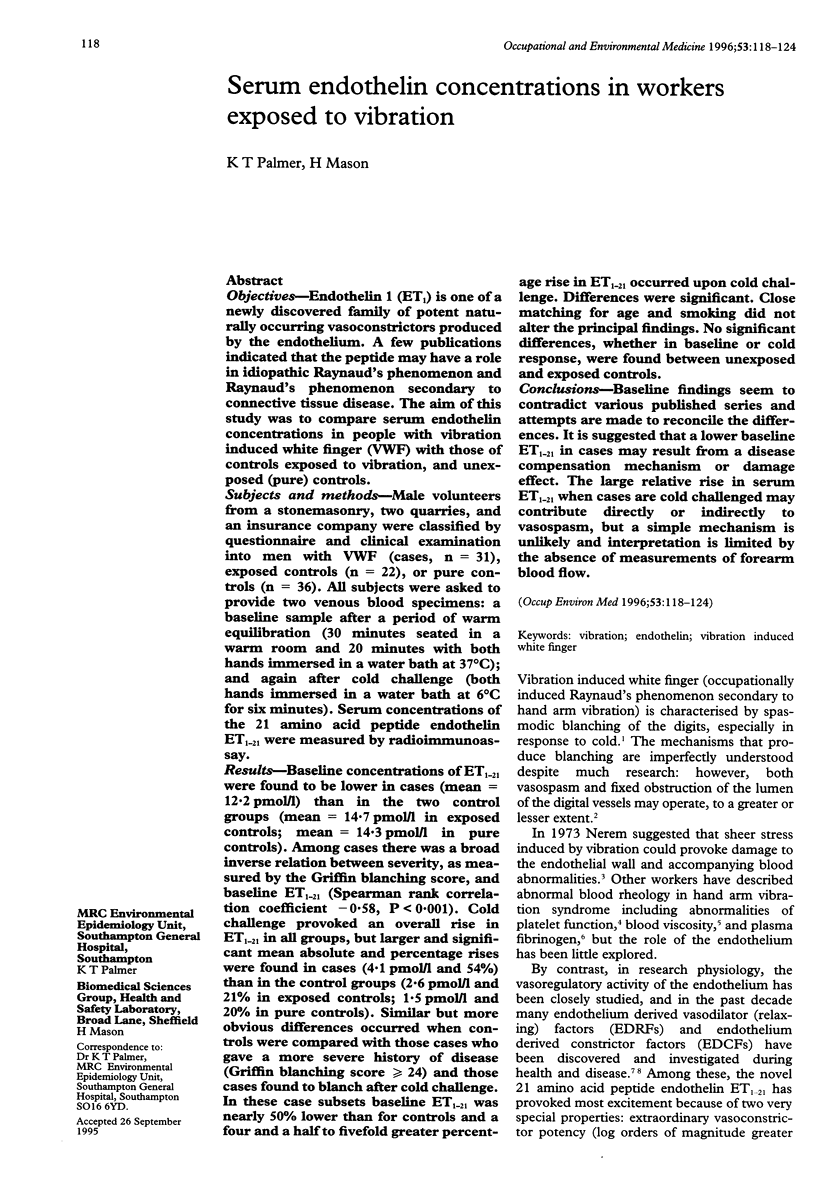
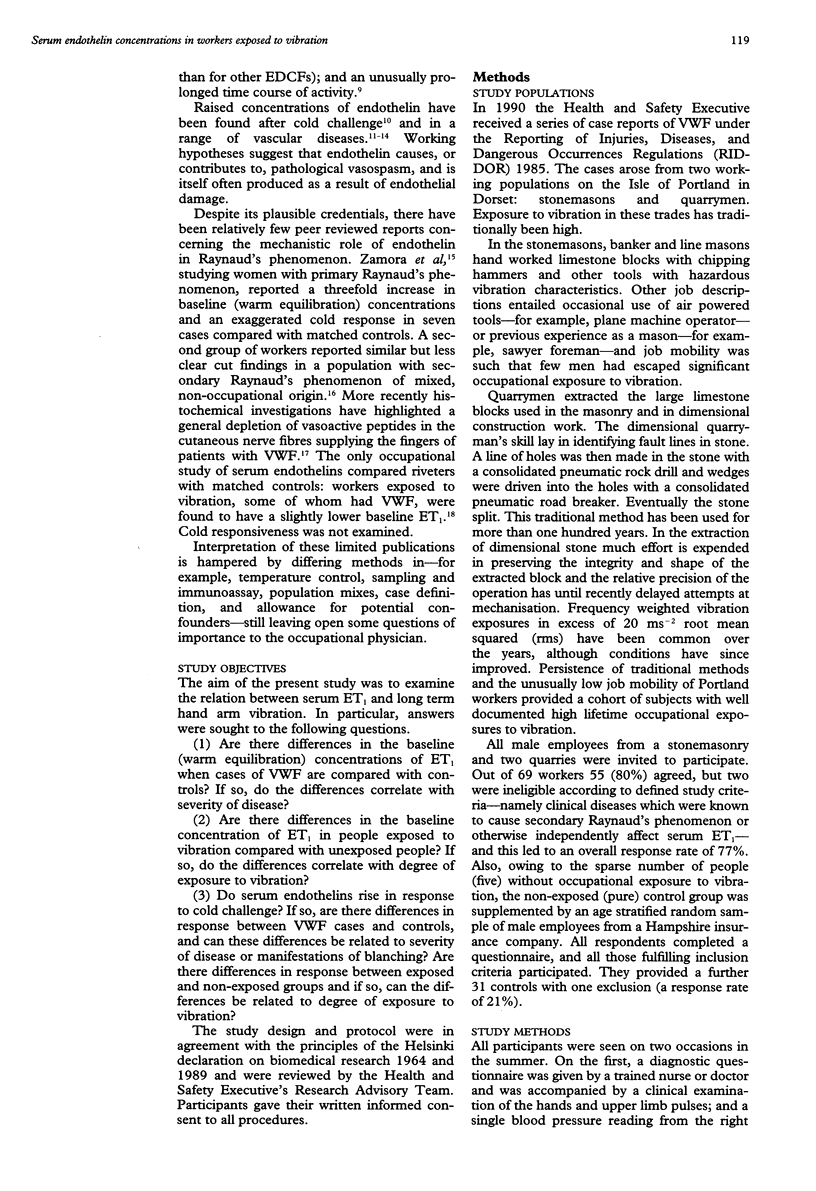
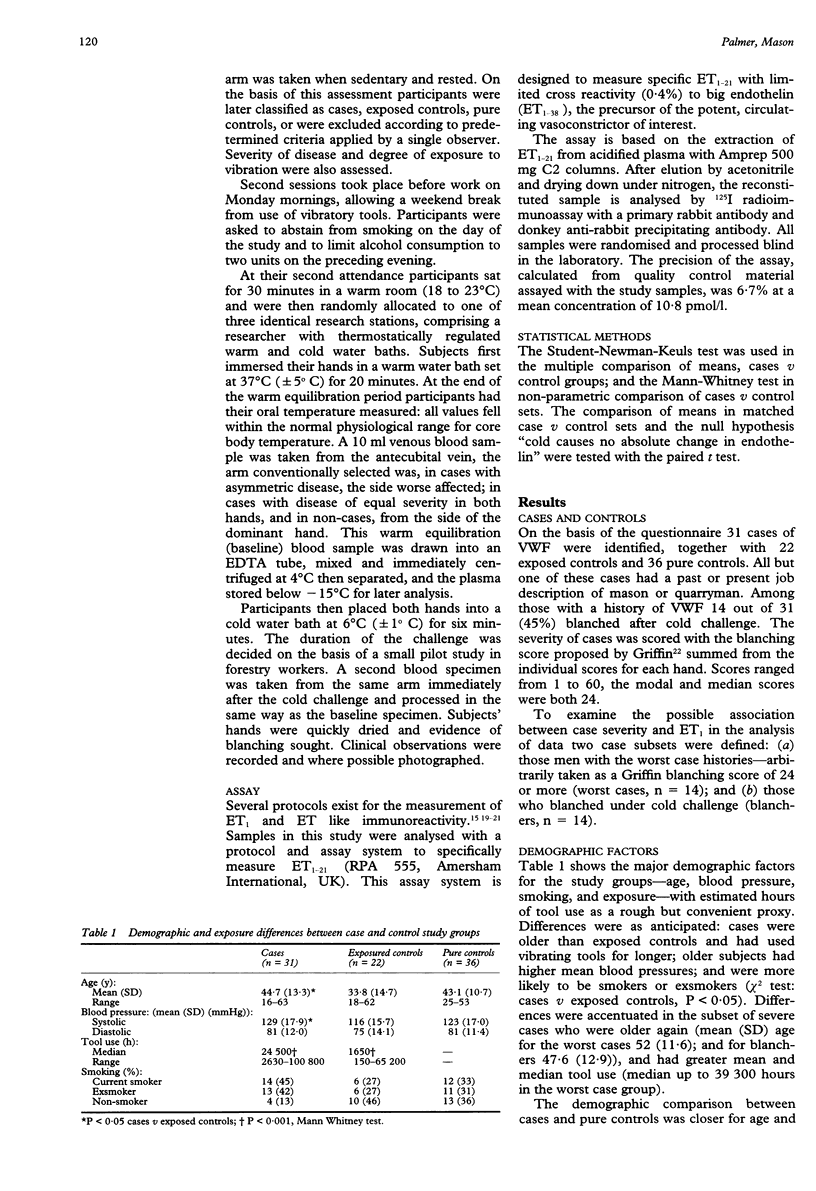
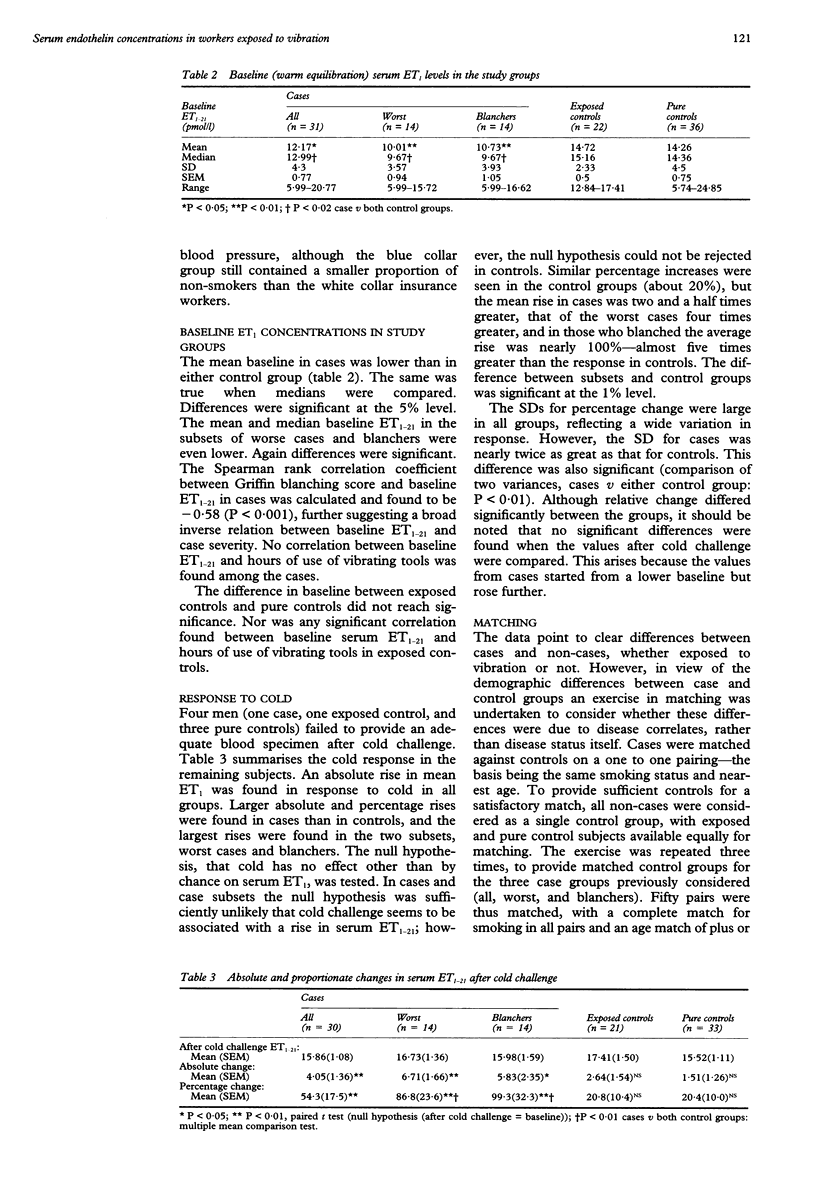
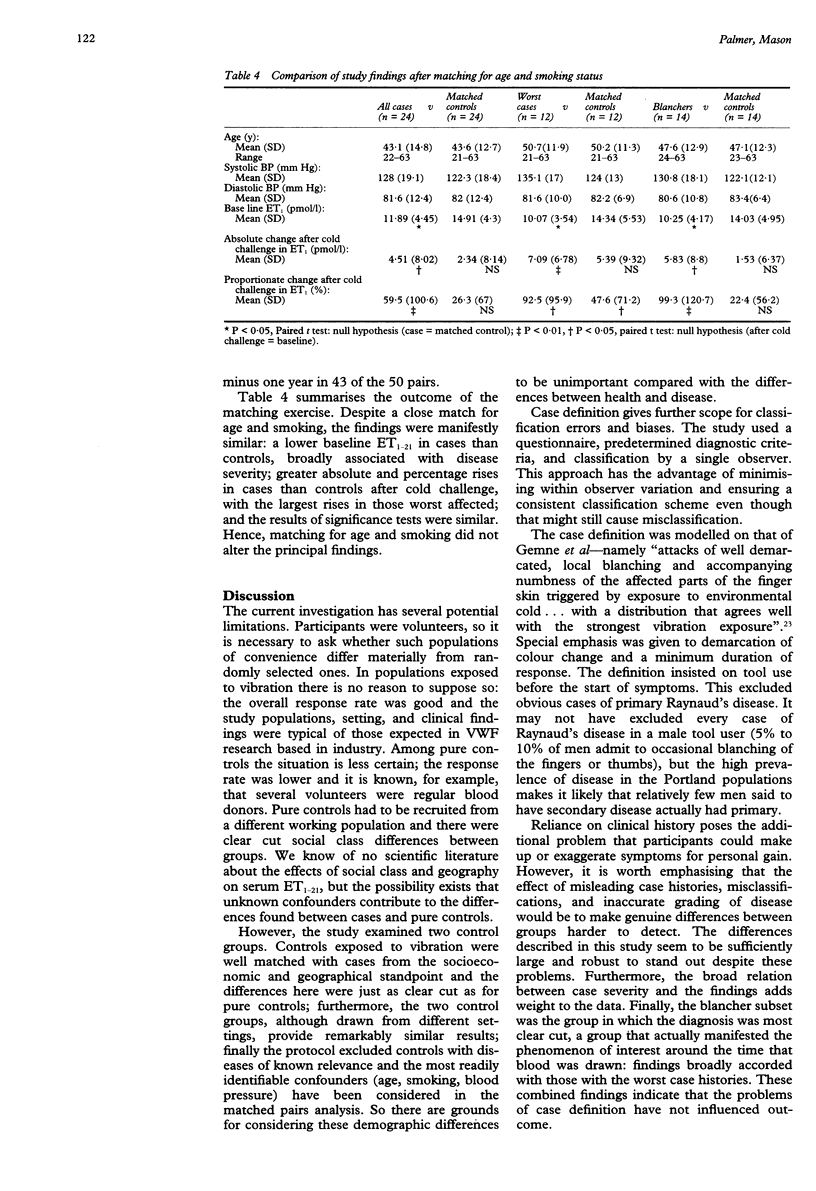
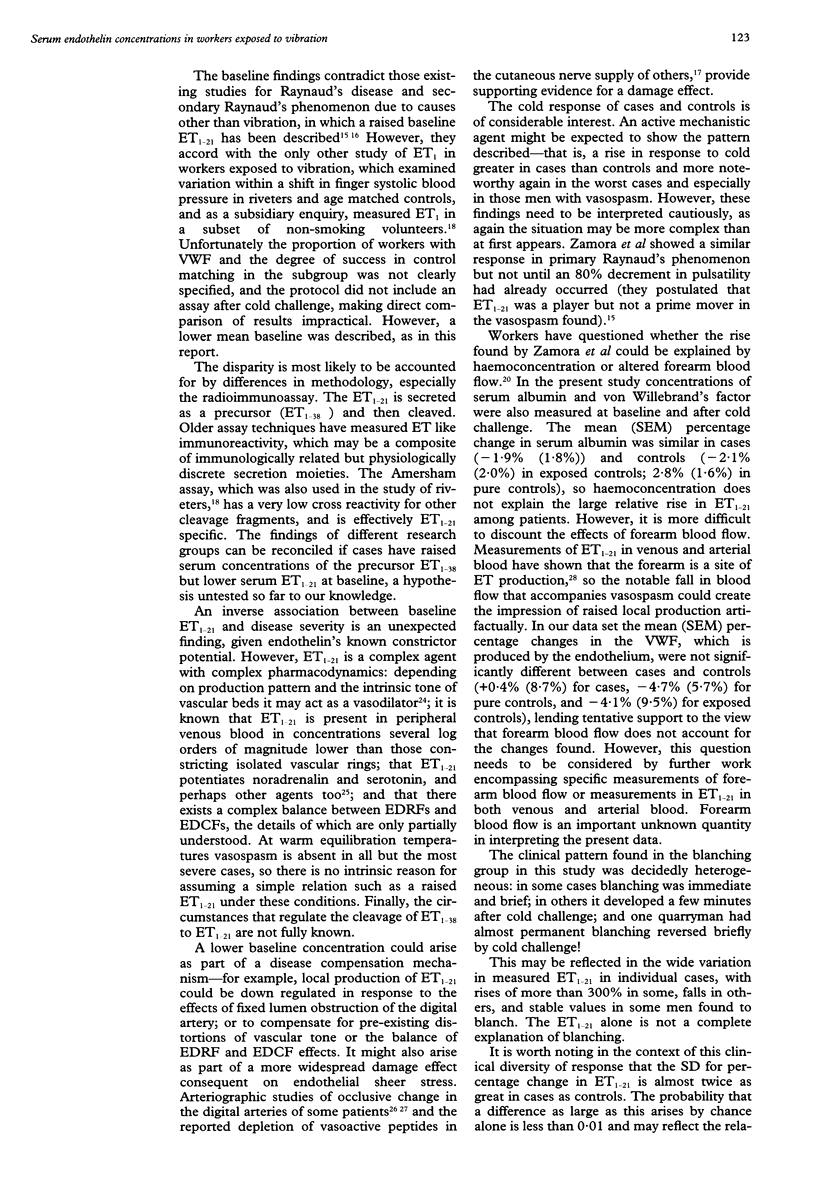
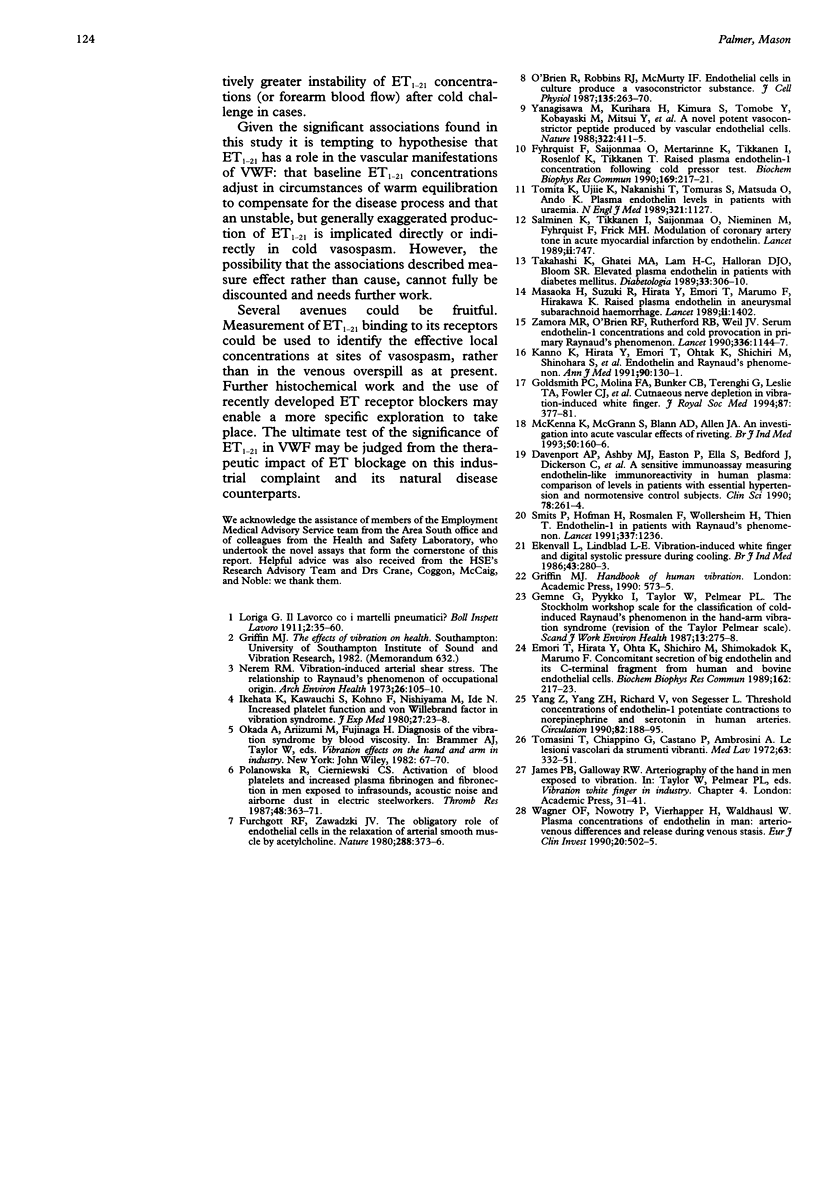
Selected References
These references are in PubMed. This may not be the complete list of references from this article.
- Davenport A. P., Ashby M. J., Easton P., Ella S., Bedford J., Dickerson C., Nunez D. J., Capper S. J., Brown M. J. A sensitive radioimmunoassay measuring endothelin-like immunoreactivity in human plasma: comparison of levels in patients with essential hypertension and normotensive control subjects. Clin Sci (Lond) 1990 Mar;78(3):261–264. doi: 10.1042/cs0780261. [DOI] [PubMed] [Google Scholar]
- Ekenvall L., Lindblad L. E. Vibration white finger and digital systolic pressure during cooling. Br J Ind Med. 1986 Apr;43(4):280–283. doi: 10.1136/oem.43.4.280. [DOI] [PMC free article] [PubMed] [Google Scholar]
- Emori T., Hirata Y., Ohta K., Shichiri M., Shimokado K., Marumo F. Concomitant secretion of big endothelin and its C-terminal fragment from human and bovine endothelial cells. Biochem Biophys Res Commun. 1989 Jul 14;162(1):217–223. doi: 10.1016/0006-291x(89)91984-0. [DOI] [PubMed] [Google Scholar]
- Furchgott R. F., Zawadzki J. V. The obligatory role of endothelial cells in the relaxation of arterial smooth muscle by acetylcholine. Nature. 1980 Nov 27;288(5789):373–376. doi: 10.1038/288373a0. [DOI] [PubMed] [Google Scholar]
- Fyhrquist F., Saijonmaa O., Metsärinne K., Tikkanen I., Rosenlöf K., Tikkanen T. Raised plasma endothelin-I concentration following cold pressor test. Biochem Biophys Res Commun. 1990 May 31;169(1):217–221. doi: 10.1016/0006-291x(90)91456-3. [DOI] [PubMed] [Google Scholar]
- Gemne G., Pyykkö I., Taylor W., Pelmear P. L. The Stockholm Workshop scale for the classification of cold-induced Raynaud's phenomenon in the hand-arm vibration syndrome (revision of the Taylor-Pelmear scale). Scand J Work Environ Health. 1987 Aug;13(4):275–278. doi: 10.5271/sjweh.2038. [DOI] [PubMed] [Google Scholar]
- Goldsmith P. C., Molina F. A., Bunker C. B., Terenghi G., Leslie T. A., Fowler C. J., Polak J. M., Dowd P. M. Cutaneous nerve fibre depletion in vibration white finger. J R Soc Med. 1994 Jul;87(7):377–381. doi: 10.1177/014107689408700703. [DOI] [PMC free article] [PubMed] [Google Scholar]
- Ikehata K., Kawauchi S., Kohno F., Nishiyama M., Ide N. Increased platelet function and von Willebrand factor in vibration syndrome. Tokushima J Exp Med. 1980 Jun;27(1-2):23–28. [PubMed] [Google Scholar]
- Kanno K., Hirata Y., Emori T., Ohta K., Shichiri M., Shinohara S., Chida Y., Tomura S., Marumo F. Endothelin and Raynaud's phenomenon. Am J Med. 1991 Jan;90(1):130–132. doi: 10.1016/0002-9343(91)90519-4. [DOI] [PubMed] [Google Scholar]
- Masaoka H., Suzuki R., Hirata Y., Emori T., Marumo F., Hirakawa K. Raised plasma endothelin in aneurysmal subarachnoid haemorrhage. Lancet. 1989 Dec 9;2(8676):1402–1402. doi: 10.1016/s0140-6736(89)92019-9. [DOI] [PubMed] [Google Scholar]
- McKenna K. M., McGrann S., Blann A. D., Allen J. A. An investigation into the acute vascular effects of riveting. Br J Ind Med. 1993 Feb;50(2):160–166. doi: 10.1136/oem.50.2.160. [DOI] [PMC free article] [PubMed] [Google Scholar]
- Nerem R. M. Vibration-induced arterial shear stress: the relationship to Raynaud's phenomenon. Arch Environ Health. 1973 Mar;26(3):105–110. doi: 10.1080/00039896.1973.10666236. [DOI] [PubMed] [Google Scholar]
- O'Brien R. F., Robbins R. J., McMurtry I. F. Endothelial cells in culture produce a vasoconstrictor substance. J Cell Physiol. 1987 Aug;132(2):263–270. doi: 10.1002/jcp.1041320210. [DOI] [PubMed] [Google Scholar]
- Polanowska R., Cierniewski C. S. Activation of blood platelets and increased plasma fibrinogen and fibronectin in men exposed to infrasounds, acoustic noise and airborne dust in electric steelworks. Thromb Res. 1987 Nov 1;48(3):363–371. doi: 10.1016/0049-3848(87)90448-8. [DOI] [PubMed] [Google Scholar]
- Salminen K., Tikkanen I., Saijonmaa O., Nieminen M., Fyhrquist F., Frick M. H. Modulation of coronary tone in acute myocardial infarction by endothelin. Lancet. 1989 Sep 23;2(8665):747–747. doi: 10.1016/s0140-6736(89)90813-1. [DOI] [PubMed] [Google Scholar]
- Takahashi K., Ghatei M. A., Lam H. C., O'Halloran D. J., Bloom S. R. Elevated plasma endothelin in patients with diabetes mellitus. Diabetologia. 1990 May;33(5):306–310. doi: 10.1007/BF00403325. [DOI] [PubMed] [Google Scholar]
- Tomita K., Ujiie K., Nakanishi T., Tomura S., Matsuda O., Ando K., Shichiri M., Hirata Y., Marumo F. Plasma endothelin levels in patients with acute renal failure. N Engl J Med. 1989 Oct 19;321(16):1127–1127. doi: 10.1056/NEJM198910193211615. [DOI] [PubMed] [Google Scholar]
- Wagner O. F., Nowotny P., Vierhapper H., Waldhäusl W. Plasma concentrations of endothelin in man: arterio-venous differences and release during venous stasis. Eur J Clin Invest. 1990 Oct;20(5):502–505. doi: 10.1111/j.1365-2362.1990.tb01892.x. [DOI] [PubMed] [Google Scholar]
- Yanagisawa M., Kurihara H., Kimura S., Tomobe Y., Kobayashi M., Mitsui Y., Yazaki Y., Goto K., Masaki T. A novel potent vasoconstrictor peptide produced by vascular endothelial cells. Nature. 1988 Mar 31;332(6163):411–415. doi: 10.1038/332411a0. [DOI] [PubMed] [Google Scholar]
- Yang Z. H., Richard V., von Segesser L., Bauer E., Stulz P., Turina M., Lüscher T. F. Threshold concentrations of endothelin-1 potentiate contractions to norepinephrine and serotonin in human arteries. A new mechanism of vasospasm? Circulation. 1990 Jul;82(1):188–195. doi: 10.1161/01.cir.82.1.188. [DOI] [PubMed] [Google Scholar]
- Zamora M. R., O'Brien R. F., Rutherford R. B., Weil J. V. Serum endothelin-1 concentrations and cold provocation in primary Raynaud's phenomenon. Lancet. 1990 Nov 10;336(8724):1144–1147. doi: 10.1016/0140-6736(90)92766-b. [DOI] [PubMed] [Google Scholar]


